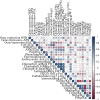Regulation of APX, SOD, and PAL genes by chitosan under salt stress in rapeseed (Brassica napus L.)
- PMID: 40604426
- PMCID: PMC12220346
- DOI: 10.1186/s12870-025-06815-0
Regulation of APX, SOD, and PAL genes by chitosan under salt stress in rapeseed (Brassica napus L.)
Abstract
Salt stress significantly impairs plant growth and productivity. This study evaluated the effects of foliar-applied chitosan on salt stress mitigation in Brassica napus L. under NaCl treatments (0, 50, 100, 150 mM). Plants were treated with chitosan (0, 5, and 10 mg/L), and their physiological, biochemical, and molecular responses were analyzed. Chitosan at 10 mg/L significantly improved biomass production, root development, and photosynthetic efficiency, increasing total chlorophyll content by up to 35% under severe salinity (150 mM NaCl). It enhanced ion homeostasis by reducing sodium (Na+) accumulation (up to 19%) and increasing potassium (K+) uptake (up to 27%), mitigating ion toxicity. Chitosan at 10 mg/L also improved membrane stability and osmotic adjustment by elevating phenolics (47%), flavonoids (40%), and anthocyanins (60%), particularly under 100 and 150 mM NaCl. Antioxidant defense mechanisms were strengthened, with 10 mg/L chitosan increasing superoxide dismutase (SOD) activity by 15%, ascorbate peroxidase (APX) by 35%, and catalase (CAT) by 168%, leading to a 30% reduction in hydrogen peroxide (H2O2) content, primarily under high salinity (100-150 mM NaCl). Additionally, chitosan upregulated the expression of stress-related genes, including SOD (55%), APX (26%), and phenylalanine ammonia-lyase (PAL) (45%), reinforcing the oxidative defense system. These findings highlight chitosan's role in salt tolerance via ion regulation, osmolyte synthesis, and antioxidant modulation, with 10 mg/L being the most effective concentration. Chitosan represents a promising biostimulant for enhancing crop resilience in saline environments. Future research should optimize formulations for large-scale applications and assess long-term effects on soil and plant health.
Keywords: Antioxidant enzymes; Chitosan; Essential elements; Oxidative damage; Salinity.
© 2025. The Author(s).
Conflict of interest statement
Declarations. Ethics approval and consent to participate: Not applicable. Consent for publication: Not applicable. Competing interests: The authors declare no competing interests.
Figures




Similar articles
-
Chitosan pre- and post-treatment modulates molecular and physiological responses to salinity in Brassica Napus L.Sci Rep. 2025 Aug 2;15(1):28219. doi: 10.1038/s41598-025-13996-z. Sci Rep. 2025. PMID: 40753266 Free PMC article.
-
Melatonin alleviates salinity-induced impairments by regulating plant growth and physiological indices of cauliflower (Brassica oleracea L.) seedlings.Int J Phytoremediation. 2025 Sep 12:1-17. doi: 10.1080/15226514.2025.2555586. Online ahead of print. Int J Phytoremediation. 2025. PMID: 40938364
-
Melatonin-Producing Bacillus aerius EH2-5 Enhances Glycine max Plants Salinity Tolerance Through Physiological, Biochemical, and Molecular Modulation.Int J Mol Sci. 2025 Aug 13;26(16):7834. doi: 10.3390/ijms26167834. Int J Mol Sci. 2025. PMID: 40869153 Free PMC article.
-
Heat stress-induced sterility in oilseed crops: a focus on Brassica napus.Mol Biol Rep. 2025 Jun 28;52(1):652. doi: 10.1007/s11033-025-10694-x. Mol Biol Rep. 2025. PMID: 40581676 Review.
-
The study on the function of the receptor kinase BnFERONIA of Brassica napus in regulating salt tolerance and ABA tolerance.Biochem Biophys Res Commun. 2025 Sep 16;780:152421. doi: 10.1016/j.bbrc.2025.152421. Epub 2025 Aug 5. Biochem Biophys Res Commun. 2025. PMID: 40829479 Review.
Cited by
-
Chitosan pre- and post-treatment modulates molecular and physiological responses to salinity in Brassica Napus L.Sci Rep. 2025 Aug 2;15(1):28219. doi: 10.1038/s41598-025-13996-z. Sci Rep. 2025. PMID: 40753266 Free PMC article.
References
-
- Cao M, Narayanan M, Shi X, Chen X, Li Z, Ma Y. Optimistic contributions of plant growth-promoting bacteria for sustainable agriculture and climate stress alleviation. Environ Res. 2023;15:217:114924. 10.1016/j.envres.2022.114924 - PubMed
-
- Shams M, Yildirim E, Khadivi A, Ekinci M, Muhie SH. Differences in seed germination, plant growth, and proline content of some pepper (Capsicum annuum L.) genotypes under salinity stress. J Crop Health. 2024;76(1):309–16. 10.1007/s10343-023-00962-w
-
- Mushtaq Z, Faizan S, Gulzar B. Salt stress, its impacts on plants and the strategies plants are employing against it: A review. J Appl Biol Biotechnol. 2020;8:81–91. 10.7324/JABB.2020.80315
MeSH terms
Substances
LinkOut - more resources
Full Text Sources
Miscellaneous

